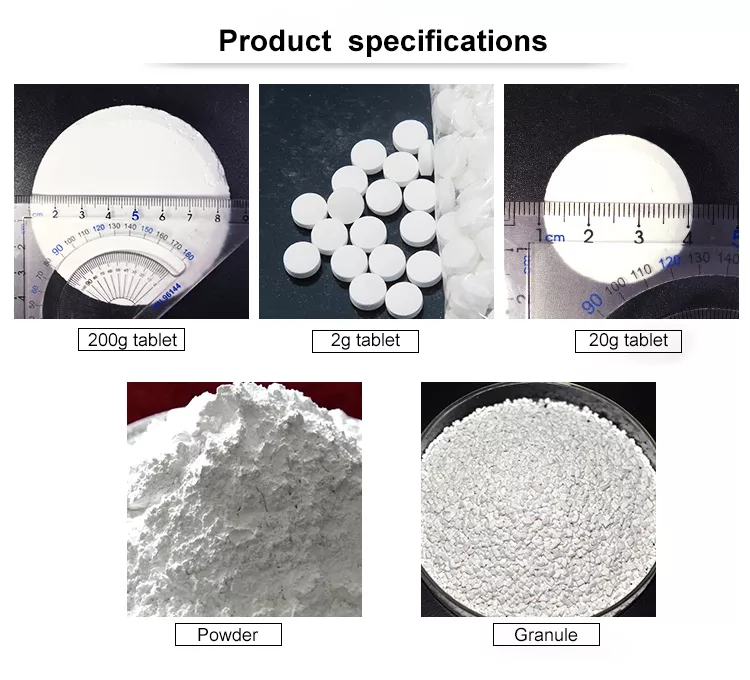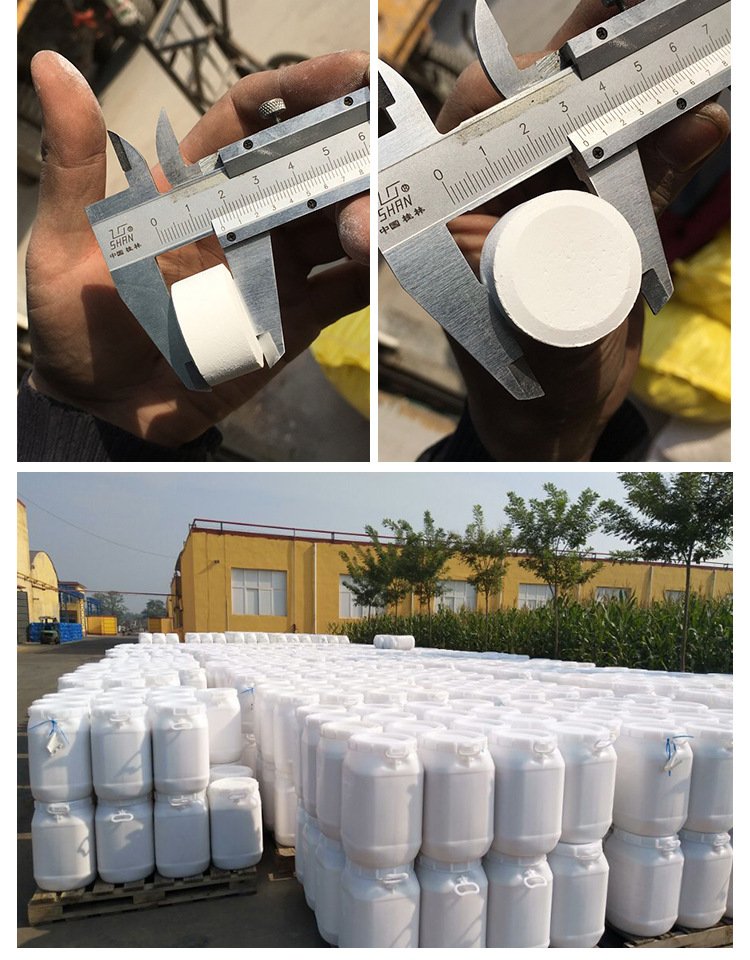Loayl Trichloroisocyanuric acid Granular has strong bactericidal and bleaching effects, and has the characteristics of fast-acting and slow-release. Trichloroisocyanuric acid is a replacement product of bleaching powder and bleaching essence. The three wastes are much lower than bleaching essence. Advanced countries use it to replace bleaching essence. This product has stronger sterilization and bleaching functions than sodium dichloroisocyanurate, and the effect is better.
| Price | $2000-2500 |
| Brand Name | Loyal |
| Model Number | Ly-02 |
| Place of Origin | Shandong,China |
| Min.Order Quantity | 20 tons |
| Payment Terms | T/T,L/C,DP,DDP |
| Supply Ability | 5000Tons/month |
| Delivery Detail | Within 15 days |
| Packaging Details | 25 kg/50 kg/1000 kg Plastic drum: 25 kg/50 k |
1. Product overview:
Loayl Trichloroisocyanuric acid Granular, alias TCCA, is a white crystalline powder or granular solid with a strong chlorine odor. Trichloroisocyanuric acid is a good oxidant and chlorinating agent, which has a killing effect on bacteria, viruses, fungi, spores, etc., and also has a certain killing effect on coccidia oocysts.
2. Product Features:
Loayl Trichloroisocyanuric acid Granular has strong bactericidal and bleaching effects, and has the characteristics of fast-acting and slow-release. Trichloroisocyanuric acid is a replacement product of bleaching powder and bleaching essence. The three wastes are much lower than bleaching essence. Advanced countries use it to replace bleaching essence. This product has stronger sterilization and bleaching functions than sodium dichloroisocyanurate, and the effect is better.
| Loayl Trichloroisocyanuric acid Granular | ||
| Name | Quality products | General products |
| Available chlorine content | 90% | 88% |
| Moisture | 0.5% | 0.8% |
| PH | 2.7-3.3 | |
4.Loayl Trichloroisocyanuric acid Granular How to use:
(1) Water quality treatment
1. Swimming pool water quality treatment
Disinfection of swimming pool water has been a headache for many years. If no treatment agent is used, the pool water needs to be replaced frequently, otherwise germs can easily grow, a slippery and dirty layer of microbial algae adheres to the pool wall, and the pool water will emit an unpleasant odor. At present, most domestic swimming pools are disinfected with bleaching powder Ca (CIO) 2, but Ca (CIO) 2 is easy to decompose, difficult to store, and easy to scale in wall pools. Acids are often used to adjust the pH value of pool water. And trichloroisocyanuric acid has four major advantages: (1) after the release of available chlorine, the remaining cyanurate has a stabilizing effect on the available chlorine in the water, and it itself is non-toxic; (2) it has little chemical effect on swimming pool water , reducing the need for pH regulators; (3) It has an outstanding killing effect on bacteria and algae in the pool; (4) It is stable in storage.
Trichloroisocyanuric acid is a very good agent for swimming pool water treatment. Long-term use can make the pool wall free of algae and non-slip, and the pool water is clear.
How to use: Put 3-5 grams of trichloroisocyanuric acid per cubic meter of water in the swimming pool every day.
2. Disinfection of drinking water
Treating drinking water with trichloroisocyanuric acid can not only kill all kinds of bacteria in the water, but also kill all kinds of algal microorganisms, destroy and eliminate the pollutants such as H2S dissolved in the water, and form the color and unpleasant smell. It is suitable for clean drinking water in arid and severely polluted areas, as well as for military field accommodation, field operations, and tourism.
Add 0.4 grams of trichloroisocyanuric acid to every 100 kilograms of water, stir well and stand for a period of time to achieve the purpose of sterilization.
(2) Industrial bleaching
Trichloroisocyanuric acid is precipitated in water to release HOCI, which undergoes an addition reaction with the conjugated bond of the fiber (ie, the chromophore), which destroys the original conjugated system, changes the wavelength of light absorption by the fiber, and achieves bleaching. Purpose. Trichloroisocyanuric acid is used for bleaching, which not only has high bleaching efficiency, but also is much less corrosive to fibers than other bleaching agents. It also improves the tensile strength and elongation of the fibers.
The suitable conditions for rayon bleaching are as follows: the concentration of trichloroisocyanuric acid is 0.5-2.0 g/L, the pH is 5.6, the operating temperature is 70°C, and the soaking time is 35-45 minutes.
The bleaching conditions for synthetic fibers such as polyester, acrylic and polyvinyl chloride are: trichloroisocyanuric acid 9.3 g/L, CA 2.6 g/L, NaHCO 32.06 g/L, soak the fibers at 20°C, squeeze dry to 100% moisture absorption %, heated with 100 ℃ steam after winding, soaked in 60 ℃ water containing NaHSO 38 g/L and HCI 1 ml/L for one hour, washed and dried to obtain fibers with extremely high whiteness. Flax bleaching conditions are: trichloroisocyanuric acid 5 g/L, PH 5.3-5.6, 60°C, soaking for 50 minutes.
The ingredients of the laundry and household rinsing agent are: trichloroisocyanuric acid 36 (wt)%, sodium tripolyphosphate 25-40 (wt)%, anhydrous sodium silicate 5 (wt)%, an appropriate amount of soda ash, the rinsing solution The dosage is 2.5 to 4.5 grams per kilogram of clothing.
(3) Disinfectants
Trichloroisocyanuric acid is a new type of disinfectant for industrial, household and environmental sanitation. The characteristic of trichloroisocyanuric acid for disinfection is that it can continuously provide a certain concentration of [O], and its own and its hydrolysis residues are harmless to the human body.
(3) Disinfectants
Trichloroisocyanuric acid is a new type of disinfectant for industrial, household and environmental sanitation. The characteristic of trichloroisocyanuric acid for disinfection is that it can continuously provide a certain concentration of [O], and its own and its hydrolysis residues are harmless to the human body.
1. Disinfection of tableware
Add 0.25 g of trichloroisocyanuric acid per 5 kg of water, and soak the washed tableware in disinfectant water for 5 minutes to achieve the purpose of disinfection.
2. Sewage and feces treatment
Add 5 grams of trichloroisocyanuric acid per cubic meter of sewage or feces to eliminate the odor.
3. Sterilization and disinfection of seeds
Using trichloroisocyanuric acid as seed disinfection can break the dormant period of seeds, improve the germination rate of seeds, and inhibit the occurrence of diseases. (At the same time, there is no environmental pollution problem, and it is harmless to humans and animals). Seeds were soaked in 0.2% trichloroisocyanuric acid aqueous solution for 12 hours.
4. Sterilization and disinfection in aquaculture
(1) Sericulture for sterilization of silkworms, silkworm tools and silkworm bodies
Water preparation: add 200 kg of water per kilogram of trichloroisocyanuric acid, stir evenly until the trichloroisocyanuric acid dissolves, and then spray and immerse it for disinfection. Each kilogram of the liquid can be sprayed on the ground or silkworm furniture 2 to 5 square meters.
Fumigation: In a closed silkworm chamber, 5 grams of medicine per cubic meter is placed on an iron plate and heated for more than 15 minutes to achieve the purpose of disinfection.
Powder: It can be mixed with lime powder, white mud, etc. in a weight ratio of 1: 200 to 1: 500 to form a powder for silkworm body and silkworm seat disinfection.
(2) Fish farming as a disease prevention and treatment agent (for reference application)
a. Prevention: Generally, the concentration of trichloroisocyanuric acid in water is controlled to be 0.2ppm, and the drug is added every 10 days.
b. Treatment: If it is found that dead fish appear in the fish pond for a short period of time and the disease is mild, sprinkle the whole pond with 0.3ppm concentration of trichloroisocyanuric acid for two consecutive days, and at the same time feed 50 grams of trichloroisocyanuric acid per 100 catties of fish for five consecutive days ( The method of feeding trichloroisocyanuric acid is to stir an appropriate amount of soybean flour or tapioca flour with boiling water into a paste, and after cooling, stir in the trichloroisocyanuric acid, and then feed it with grass). If the onset time is long and the disease is severe, the number of days of feeding can be increased. And the concentration of the whole pool can be increased to o.4ppm.
5. Used for disinfection of sewage, laundry house towels, diapers, bedpans, medicine bowls and instruments
Compared with the commonly used Xinjieermin, carbolic acid, chlorhexidine, and chloramine T, the dosage of trichloroisocyanuric acid is only 1/10~1/100 of the above-mentioned conventional disinfectants for the same disinfection object, and the sterilization speed is fast and effective. Okay.
6. Disinfectant and deodorant for household and public wastes
Its formula is: trichloroisocyanuric acid 25%, sodium tripolyphosphate 25-65%, p-dichlorobenzene 10-15%, and is suitable for disinfection and deodorization of toiletware, garbage and gutter.
(4) Anti-shrinkage treatment of wool
The outer surface of the wool fiber is covered with a layer of scales. Due to the relative movement of the scales, the so-called felting effect occurs, which gradually shrinks the wool fabric, resulting in longitudinal and transverse shrinkage. Trichloroisocyanuric acid is decomposed into hypochlorous acid in water, and then decomposes to release the new ecological atomic oxygen [O], which interacts with proteins, destroys part of the disulfide bridge molecules of the protein molecules, and converts them into sulfhydryl bridges, eliminating the scaly skin of wool. So as to prevent the contraction of the day. Trichloroisocyanuric acid not only reduces felting, but also improves the gloss and dyeability of wool, and the shrinkage of wool is also reduced from more than 35% to less than 5%. Treated fibers do not shrink or pill.
(5) Three-waste treatment and other applications
1. The sewage containing CN and Hg is used for the treatment of CN and Hg sewage. CN can be converted into harmless substances within 5-10 minutes, and the conversion rate is as high as 99.9%.
2. Bonding agent
After dissolving trichloroisocyanuric acid in ethyl ester solvent, surface treatment of the rubber sole of leather shoes can accelerate the penetration of the adhesive and double the adhesive force.
3. Crop disease prevention and treatment
The crops are sprayed with trichloroisocyanuric acid diluted 500 to 800 times with water, which has certain preventive and inhibitory effects on sticky blight, rice blast, thin strip disease, bakanae disease and rust.
5. Application areas:
Loayl Trichloroisocyanuric acid Granular has been used as a sterilant in industrial water, swimming pool water, cleaning agent, tableware, etc.; used as a sterilant in sericulture and other aquaculture; in the bleaching of cyanide-treated towels in wool shrink-resistant fabrics and paper, etc. Widely used in food processing, drinking water disinfection, sericulture and rice seed disinfection, can be used as a bleaching agent in the textile and paper industry, fruit preservation, decolorization, deodorization and sterilization of daily chemicals, and wool shrinkage. It is also widely used in the production of polyurethane synthetic leather shoes, rubber chlorination, battery materials and organic synthesis.

6. Product/sample packaging scheme and storage:
Avoid direct sunlight
A cool and ventilated place
24 months shelf life

7, Matters needing attention:
Packed in plastic woven bags of 25kg/bag and 50kg/drum. The samples are packaged in aluminum foil bags. This product is a disinfectant for external use and should not be taken orally; it should be stored in a ventilated and dry place, protected from moisture, water and fire. To prevent damage to the package during transportation; open the package to ventilate before use to avoid inhalation.